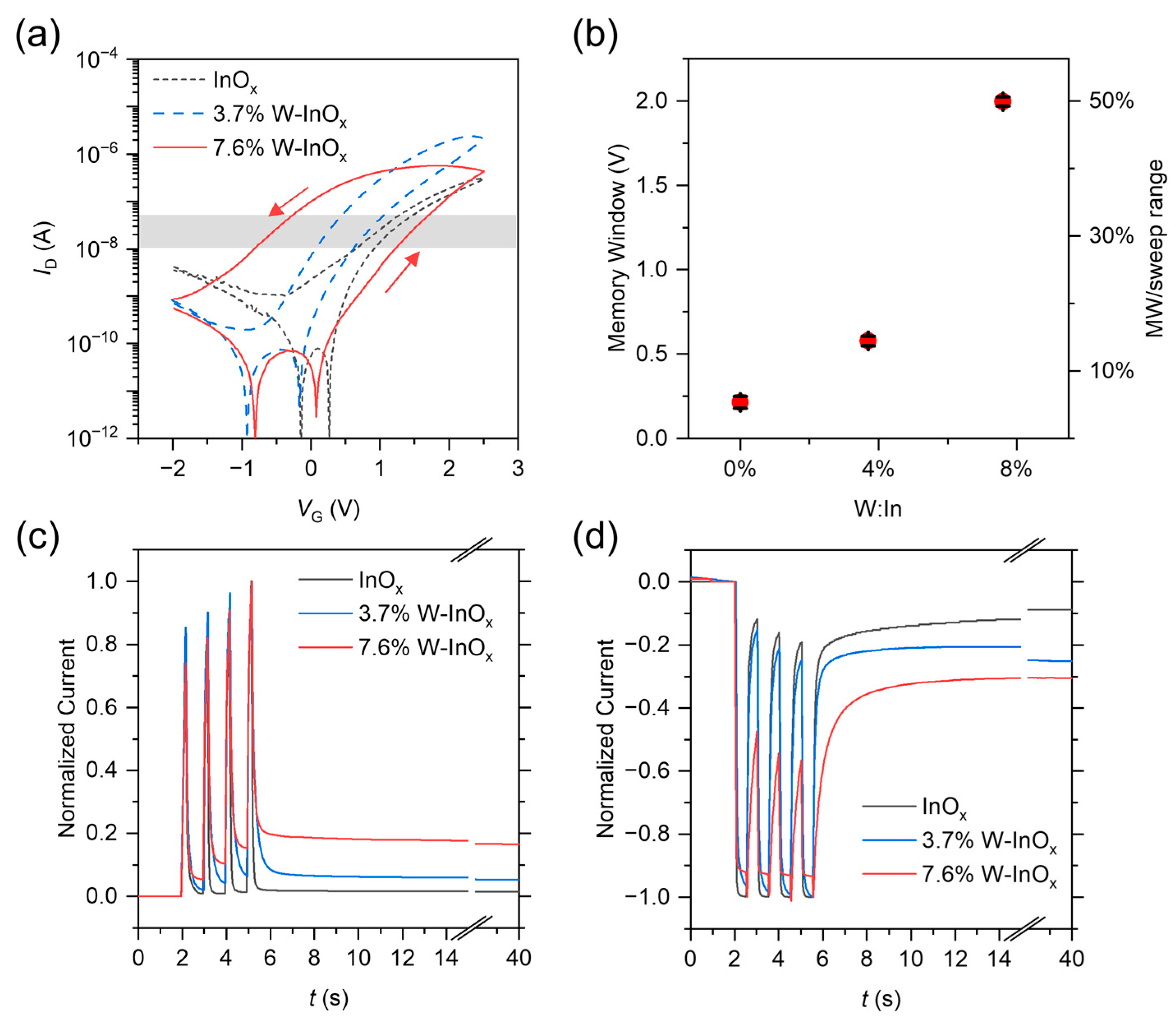An Enhanced Synaptic Plasticity of Electrolyte-Gated Transistors through the Tungsten Doping of an Oxide Semiconductor
Abstract
:1. Introduction
2. Materials and Methods
3. Results
4. Conclusions
Author Contributions
Funding
Data Availability Statement
Conflicts of Interest
References
- Sun, C.; Liu, X.; Jiang, Q.; Ye, X.; Zhu, X.; Li, R.-W. Emerging electrolyte-gated transistors for neuromorphic perception. Sci. Technol. Adv. Mater. 2023, 24, 2162325. [Google Scholar] [CrossRef] [PubMed]
- He, K.; Wang, C.; He, Y.; Su, J.; Chen, X. Artificial Neuron Devices. Chem. Rev. 2023, 123, 13796–13865. [Google Scholar] [CrossRef] [PubMed]
- Du, H.; Lin, X.; Xu, Z.; Chu, D. Electric double-layer transistors: A review of recent progress. J. Mater. Sci. 2015, 50, 5641–5673. [Google Scholar] [CrossRef]
- Liang, X.; Li, Z.; Liu, L.; Chen, S.; Wang, X.; Pei, Y. Artificial synaptic transistor with solution processed InOx channel and AlOx solid electrolyte gate. Appl. Phys. Lett. 2020, 116, 012102. [Google Scholar] [CrossRef]
- Sun, J.; Oh, S.; Choi, Y.; Seo, S.; Oh, M.J.; Lee, M.; Lee, W.B.; Yoo, P.J.; Cho, J.H.; Park, J.H. Optoelectronic Synapse Based on IGZO-Alkylated Graphene Oxide Hybrid Structure. Adv. Funct. Mater. 2018, 28, 1804397. [Google Scholar] [CrossRef]
- Yang, Y.; Wen, J.; Guo, L.; Wan, X.; Du, P.; Feng, P.; Shi, Y.; Wan, Q. Long-Term Synaptic Plasticity Emulated in Modified Graphene Oxide Electrolyte Gated IZO-Based Thin-Film Transistors. ACS Appl. Mater. Interfaces 2016, 8, 30281–30286. [Google Scholar] [CrossRef]
- He, Y.; Jiang, S.; Chen, C.; Wan, C.; Shi, Y.; Wan, Q. Electrolyte-gated neuromorphic transistors for brain-like dynamic computing. J. Appl. Phys. 2021, 130, 190904. [Google Scholar] [CrossRef]
- Mortimer, R.J. Electrochromic Materials. Annu. Rev. Mater. Res. 2011, 41, 241–268. [Google Scholar] [CrossRef]
- Ding, G.; Zhao, J.; Zhou, K.; Zheng, Q.; Han, S.-T.; Peng, X.; Zhou, Y. Porous crystalline materials for memories and neuromorphic computing systems. Chem. Soc. Rev. 2023, 52, 7071–7136. [Google Scholar] [CrossRef]
- Cui, Y.; Wang, Q.; Yang, G.; Gao, Y. Electronic properties, optical properties and diffusion behavior of WO3 with H+, Li+ and Na+ intercalated ions: A first-principles study. J. Solid State Chem. 2021, 297, 122082. [Google Scholar] [CrossRef]
- Yang, J.T.; Ge, C.; Du, J.Y.; Huang, H.Y.; He, M.; Wang, C.; Lu, H.B.; Yang, G.Z.; Jin, K.J. Artificial Synapses Emulated by an Electrolyte-Gated Tungsten-Oxide Transistor. Adv. Mater. 2018, 30, 1801548. [Google Scholar] [CrossRef] [PubMed]
- Liang, X.; Liu, L.; Cai, G.; Yang, P.; Pei, Y.; Liu, C. Evidence for Pseudocapacitance and Faradaic Charge Transfer in High-Mobility Thin-Film Transistors with Solution-Processed Oxide Dielectrics. J. Phys. Chem. Lett. 2020, 11, 2765–2771. [Google Scholar] [CrossRef] [PubMed]
- Chattaraj, A.; Khan, S.; Walczak, L.; Kanjilal, A. Probing the impact of surface reactivity on charge transport in dimensional phase changed tungsten films. J. Mater. Sci. Mater. Electron. 2019, 30, 8278–8285. [Google Scholar] [CrossRef]
- Patel, C.; Chaudhary, S.; Verma, V.K.; Dubey, M.; Sriram, S.; Mukherjee, S. Photoactivated Pd-Loaded WO3 for Enhanced H2 S Sensing. IEEE Sens. J. 2023, 23, 12552–12558. [Google Scholar] [CrossRef]
- Tang, X.; Yang, L.; Huang, J.; Chen, W.; Li, B.; Yang, S.; Yang, R.; Zeng, Z.; Tang, Z.; Gui, X. Controlling sulfurization of 2D Mo2C crystal for Mo2C/MoS2-based memristor and artificial synapse. npj Flex. Electron. 2022, 6, 93. [Google Scholar] [CrossRef]
- Zucker, R.S.; Regehr, W.G. Short-Term Synaptic Plasticity. Annu. Rev. Physiol. 2002, 64, 355–405. [Google Scholar] [CrossRef] [PubMed]
- Gong, Y.; Wang, Y.; Li, R.; Yang, J.-Q.; Lv, Z.; Xing, X.; Liao, Q.; Wang, J.; Chen, J.; Zhou, Y.; et al. Tailoring synaptic plasticity in a perovskite QD-based asymmetric memristor. J. Mater. Chem. C 2020, 8, 2985–2992. [Google Scholar] [CrossRef]
- Zinebi, F.; Russell, R.T.; McKernan, M.; Shinnick-Gallagher, P. Comparison of paired-pulse facilitation of AMPA and NMDA synaptic currents in the lateral amygdala. Synapse 2001, 42, 115–127. [Google Scholar] [CrossRef] [PubMed]
- Han, C.; Han, X.; Han, J.; He, M.; Peng, S.; Zhang, C.; Liu, X.; Gou, J.; Wang, J. Light-Stimulated Synaptic Transistor with High PPF Feature for Artificial Visual Perception System Application. Adv. Funct. Mater. 2022, 32, 2113053. [Google Scholar] [CrossRef]
- Chen, C.; Yang, B.R.; Li, G.; Zhou, H.; Huang, B.; Wu, Q.; Zhan, R.; Noh, Y.Y.; Minari, T.; Zhang, S.; et al. Analysis of Ultrahigh Apparent Mobility in Oxide Field-Effect Transistors. Adv. Sci. 2019, 6, 1801189. [Google Scholar] [CrossRef]
- Wang, Z.; Wang, H.; Gu, X.; Cui, H.-N. Hierarchical structure WO3/TiO2 complex film with enhanced electrochromic performance. Solid State Ion. 2019, 338, 168–176. [Google Scholar] [CrossRef]
- Wang, S.; Chen, X.; Zhao, C.; Kong, Y.; Lin, B.; Wu, Y.; Bi, Z.; Xuan, Z.; Li, T.; Li, Y.; et al. An organic electrochemical transistor for multi-modal sensing, memory and processing. Nat. Electron. 2023, 6, 281–291. [Google Scholar] [CrossRef]
- Li, J.; Lei, Y.; Wang, Z.; Meng, H.; Zhang, W.; Li, M.; Tan, Q.; Li, Z.; Guo, W.; Wen, S.; et al. High-Density Artificial Synapse Array Consisting of Homogeneous Electrolyte-Gated Transistors. Adv. Sci. 2023, 11, 2305430. [Google Scholar] [CrossRef] [PubMed]





Disclaimer/Publisher’s Note: The statements, opinions and data contained in all publications are solely those of the individual author(s) and contributor(s) and not of MDPI and/or the editor(s). MDPI and/or the editor(s) disclaim responsibility for any injury to people or property resulting from any ideas, methods, instructions or products referred to in the content. |
© 2024 by the authors. Licensee MDPI, Basel, Switzerland. This article is an open access article distributed under the terms and conditions of the Creative Commons Attribution (CC BY) license (https://creativecommons.org/licenses/by/4.0/).
Share and Cite
Xie, D.; Liang, X.; Geng, D.; Wu, Q.; Liu, C. An Enhanced Synaptic Plasticity of Electrolyte-Gated Transistors through the Tungsten Doping of an Oxide Semiconductor. Electronics 2024, 13, 1485. https://doi.org/10.3390/electronics13081485
Xie D, Liang X, Geng D, Wu Q, Liu C. An Enhanced Synaptic Plasticity of Electrolyte-Gated Transistors through the Tungsten Doping of an Oxide Semiconductor. Electronics. 2024; 13(8):1485. https://doi.org/10.3390/electronics13081485
Chicago/Turabian StyleXie, Dongyu, Xiaoci Liang, Di Geng, Qian Wu, and Chuan Liu. 2024. "An Enhanced Synaptic Plasticity of Electrolyte-Gated Transistors through the Tungsten Doping of an Oxide Semiconductor" Electronics 13, no. 8: 1485. https://doi.org/10.3390/electronics13081485





